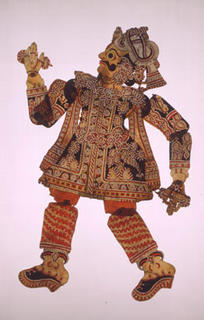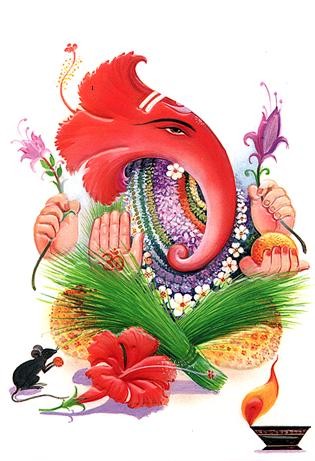తోలు బొమ్మలాట
Tollu Bommalu (Tholu Bommalatta) is one of the best known forms of puppetry in India, and is the best example of the wonderfully varied forms of shadow-puppet Theatre in Asia. It is found in several regions of Andhra Pradesh state in south India. Tolu means a 'leather' and bommalu means 'doll'.
 According to the oral tradition, the form originated in 200 BC when it was patronized by the rulers of the Satvahana dynasty. In the 16th century during the reign of King Kona Reddy, a ruler of the Vijayanagar Empire, a Telugu manuscript entitled Ramayana Ranganathana was composed specifically for the shadow theatre. Besides providing a dramatic text of the famous epic story, the manuscript includes instructions for the constructions and decoration of SHADOW PUPPETS. Families of puppeteers even today jealously guard copies of the manuscripts from outside study.
According to the oral tradition, the form originated in 200 BC when it was patronized by the rulers of the Satvahana dynasty. In the 16th century during the reign of King Kona Reddy, a ruler of the Vijayanagar Empire, a Telugu manuscript entitled Ramayana Ranganathana was composed specifically for the shadow theatre. Besides providing a dramatic text of the famous epic story, the manuscript includes instructions for the constructions and decoration of SHADOW PUPPETS. Families of puppeteers even today jealously guard copies of the manuscripts from outside study.
Puppets are cut from various types of hide and processed in a special manner. Most puppets, including humans and saints, are made of goat skin. Demons are carved of buffalo hide, and gods and heroes of deerskin. Puppets are large, translucent and multi coloured. The puppets from Madanapally District are 4ft tall and those from Kakinada are as tall as 5ft.
The leather puppet is wedged into a split bamboo strip and tied along the length of the strip from the head to the crotch to provide support. Different emotional streets of a character are depicted by separate puppets. For example to show a scenic environment a tree puppet is shown. Many puppets have movable hands and legs and some, movable heads and necks. Puppets are dyed black, red and green: For females and sages the dominant colour is yellow. The colourful
shadows are cast on a wide white screen made of sturdy cotton cloths.

The chief manipulator stands behind the screen manipulating the puppets using strings tied to them. For big puppets two people manipulate each puppet.
 A typical troupe of between six and ten people is composed of manipulators, singers, dancers and instrumentalist. Women speak the female part and stage manager manipulates the shadows during dance numbers.
A typical troupe of between six and ten people is composed of manipulators, singers, dancers and instrumentalist. Women speak the female part and stage manager manipulates the shadows during dance numbers.
Musicians play mridangam drum, bell metal cymbals, and sometimes harmonium and mukavina, and oboe-like wind instrument special effects delight the audience. for example when a character is shot with an arrow during a battle, a whizzing noise is produced by a small whistle as a leather arrow, on a rod is whisked across the screen. When it strikes the victim, severing his head, the puppet head is detached quickly by a string and made to roll across the screen. Drummers accentuate the action with loud thuds.
The stage manager introduces the subject of the play and the preliminaries and the introduction of characters is given. When the play starts and ends after a minimum of two hours.
 According to the oral tradition, the form originated in 200 BC when it was patronized by the rulers of the Satvahana dynasty. In the 16th century during the reign of King Kona Reddy, a ruler of the Vijayanagar Empire, a Telugu manuscript entitled Ramayana Ranganathana was composed specifically for the shadow theatre. Besides providing a dramatic text of the famous epic story, the manuscript includes instructions for the constructions and decoration of SHADOW PUPPETS. Families of puppeteers even today jealously guard copies of the manuscripts from outside study.
According to the oral tradition, the form originated in 200 BC when it was patronized by the rulers of the Satvahana dynasty. In the 16th century during the reign of King Kona Reddy, a ruler of the Vijayanagar Empire, a Telugu manuscript entitled Ramayana Ranganathana was composed specifically for the shadow theatre. Besides providing a dramatic text of the famous epic story, the manuscript includes instructions for the constructions and decoration of SHADOW PUPPETS. Families of puppeteers even today jealously guard copies of the manuscripts from outside study.Puppets are cut from various types of hide and processed in a special manner. Most puppets, including humans and saints, are made of goat skin. Demons are carved of buffalo hide, and gods and heroes of deerskin. Puppets are large, translucent and multi coloured. The puppets from Madanapally District are 4ft tall and those from Kakinada are as tall as 5ft.
The leather puppet is wedged into a split bamboo strip and tied along the length of the strip from the head to the crotch to provide support. Different emotional streets of a character are depicted by separate puppets. For example to show a scenic environment a tree puppet is shown. Many puppets have movable hands and legs and some, movable heads and necks. Puppets are dyed black, red and green: For females and sages the dominant colour is yellow. The colourful
shadows are cast on a wide white screen made of sturdy cotton cloths.

The chief manipulator stands behind the screen manipulating the puppets using strings tied to them. For big puppets two people manipulate each puppet.
 A typical troupe of between six and ten people is composed of manipulators, singers, dancers and instrumentalist. Women speak the female part and stage manager manipulates the shadows during dance numbers.
A typical troupe of between six and ten people is composed of manipulators, singers, dancers and instrumentalist. Women speak the female part and stage manager manipulates the shadows during dance numbers.Musicians play mridangam drum, bell metal cymbals, and sometimes harmonium and mukavina, and oboe-like wind instrument special effects delight the audience. for example when a character is shot with an arrow during a battle, a whizzing noise is produced by a small whistle as a leather arrow, on a rod is whisked across the screen. When it strikes the victim, severing his head, the puppet head is detached quickly by a string and made to roll across the screen. Drummers accentuate the action with loud thuds.
The stage manager introduces the subject of the play and the preliminaries and the introduction of characters is given. When the play starts and ends after a minimum of two hours.



6 Comments:
michael kors outlet
coach outlet online
nike shoes
michael kors uk
hugo boss suits
coach outlet online
oakley sunglasses
michael kors handbags
nike free run
rolex replica watches
2017.8.16
ugg outlet
adidas nmd
broncos jerseys
ugg boots
michael kors outlet
ugg boots
ralph lauren outlet
nba jerseys
nike outlet
coach outlet
jaguars jersey
ray ban sunglasses outlet
skechers outlet
christian louboutin shoes
san francisco 49ers jerseys
nike shoes
michael kors
ray ban sunglasses
oklahoma city thunder
nike shoes
michael kors uk
fitflops
birkenstock outlet
coach factory outlet
canada goose sale
discount oakley sunglasses
armani exchange
minnesota vikings jerseys
cleveland browns jerseys
oakley sunglasses
issey miyake
christian louboutin outlet
ralph lauren uk
converse shoes
ray ban sunglasses
christian louboutin outlet
snapbacks wholesale
christian louboutin shoes
nfl jerseys
basket nike femme
wqweq0820
travis scott jordan
gap yeezy
supreme shirt
yeezy
off white nike
hermes
palm angels
jordan travis scott
yeezy 350
supreme
Post a Comment
<< Home